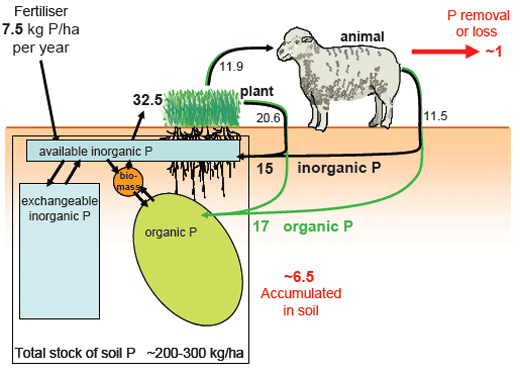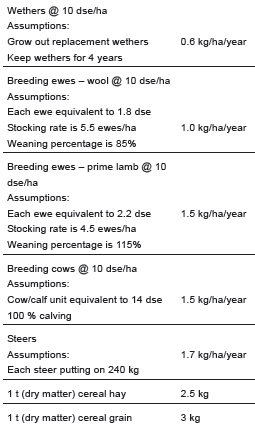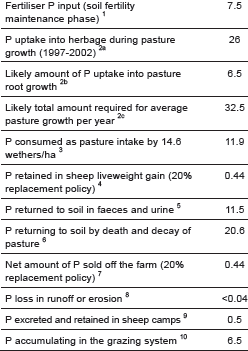



Cycling of Phosphorus in Grazing Systems
Before addressing soil phosphorus levels under pastures it is important to gain a better understanding of the phosphorus cycle operating in our soils supporting pasture which is grazed by livestock, writes Fiona Leech, District Agronomist, NSW DPI. This report is a primefacts publication.Introduction
In the soil there are a number of different phosphorus pools constantly interacting. These pools include:
- plant-available inorganic P (water soluble P)
- organic P (P associated with living and dead organic matter)
- less available inorganic P (poorly soluble mineral P tightly bound to clay particles).
Plant-available inorganic P
Inorganic P is phosphorus associated with non-living material, e.g. soil, mineral compounds, fertiliser. Inorganic P is present in forms that range from being sparingly soluble and consequently poorly available to plants through to more soluble forms that are potentially available for plants to use. Most of the plant-available P is adsorbed to clay minerals in the soil.
The amount of inorganic P that is found in soil solution is usually very small (about 1 per cent of the total P present in the soil) and as plants use this P for their growth it must be replenished by P released from the clay minerals. If the soil has a low P status and the rate of supply to the plants is slower than it needs for its growth, the rate of pasture growth will be restricted. This may be the case if inadequate fertiliser has been applied or if fertiliser applications have been suspended.
Organic P
Organic P is phosphorus in the soil that is chemically bound in organic matter. Biological activity by micro-organisms, worms, beetles, etc. in soil results in organic matter being broken down and this releases P into the plant-available inorganic form. Rumen gut bacteria also digest organic materials, releasing P from the organic form into the plant-available inorganic P form.
The decaying of plant material and the addition of dung and urine to the soil increase the amount of P cycling through the organic P pool. However, the only way that the total amount of P in the paddock system can increase is by importing feed, fertiliser or other forms of organic matter to the paddock.
Less available inorganic P
Some of the P associated with non-living material can be very tightly bound to soil particles or in very sparingly soluble compounds. P may be released from this pool to the plant-available inorganic P pool but this usually happens very slowly.
Figure 1 shows the pathway that P takes in a grazed pasture system. The following points describe the detail of the system.
- Pasture growth each year needs P and this is taken up by the plant from the plant-available inorganic P pool. Typically pasture growth may use 3–4 times more P than that supplied as fertiliser P. This is because a large amount of P is always supplied from the P cycling in the soil and the fertiliser input is only intended to top up usage and losses from the system.
- Animals eat a proportion of the pasture. In Figure 1 it is assumed that the utilisation rate of pasture by grazing animals is in the order of 50 per cent. The remaining proportion of the pasture ultimately decays and returns organic P and inorganic P to the soil.
- The plant material eaten by the animal is digested and some of the organic P in the plant is broken down by microbes in the rumen and converted to the plant-available inorganic P form. There is also P that remains in the organic P form during digestion. A growing animal will use a small amount of P for its own requirements and excrete excess P in the form of faeces and urine back into the soil to add to the soil organic and inorganic P pools.
- The amount of P removed from a pasture system depends on the amount of animal product sold off the farm because P losses in leaching and soil erosion should (if the system is well managed) be very small. Table 1 shows some typical P losses in animal products as well as grain.
- The activity of soil micro-organisms and earthworms, etc. interacting with the organic P pool will release P into the plant-available inorganic P pool.
- As more pasture is grown, more plant material is returned to the soil via faeces and urine through the animal or directly through decaying pasture plants, hence building the organic and inorganic P pools. As these two P pools increase in size, so too does the amount of micro-organisms present in the soil. The higher level of microbial activity will result in higher levels of P moving into the plant-available inorganic P pool.
- When applying fertiliser at maintenance or above maintenance rates there is a slow accumulation of P to the total soil P pool. Due to the higher levels of pasture grown under increased soil fertility, more plant material is returned to the soil, not only building the amount of P that cycles in the system but also building the soil organic carbon levels.
- Using fertiliser consequently gives an immediate benefit to the current year’s pasture growth but also builds the potential fertility level of the soil.


Take home messages
The main outcome of applying fertiliser P is to feed the soil and nutrient cycles and thus to lift the availability of P for pasture growth. Fertiliser P will build the organic P cycle by increasing the levels of organic matter that is in turn used by soil micro-organisms. Fertiliser P will also build the rate of inorganic P cycling in the soil and this helps to maintain levels of the plant-available inorganic P pool.
Irrespective of the fertiliser form being used in our grazing systems, it is very clear that the release of P for plant growth is highly dependent on organic nutrient cycling. Whether P is applied in the form of a mineral fertiliser (e.g. superphosphate) or an organic fertiliser form, it is fed into the soil P cycle to help raise the availability of P to the plants over time. Soluble mineral fertilisers help to raise plant-available P levels quickly but also increase the organic P cycle. By contrast, organic P fertilisers must enter the organic cycle before mineral P will be released for plant use.
The increase in soil P status and P cycling depends on the amount of P being added to the soil (irrespective of P form) and its ability to promote pasture growth. It is the production of more pasture that most effectively increases the size of the organic P pool. This in turn raises the level of soil micro-organisms and hence the level of P in the plant-available inorganic P pool. The objective of applying a P fertiliser is therefore to build the availability of P for plants and the cycling of P to maintain this availability. Fertilising in excess of the point where the needs of pasture growth are met will be a waste of money. At this point fertiliser inputs may be reduced to maintenance P applications addressing P losses and holding soil P fertility at the ideal level.

- Average maintenance fertiliser input = 83 kg superphosphate/ha/year.
- Average amount of pasture grown per year = 9.3 t (estimated using the GrassGro grazing systems model). The average P concentration of herbage was assumed to be 0.28 per cent of DM (Fulkerson et al. 1998), shoot: root ratio is assumed to be 2 and root P concentration to be half that of the herbage.
- Average intake of 0.8 kg DM/day is assumed (~45 per cent pasture utilisation)
- Culls sold at 50 kg LW and replaced with 25 kg weaners. Liveweight gain assumed to be 25 kg/ha/year with a P concentration of 6 g P/kg LW (SCA 1990).
- Only growing sheep show net retention of P in their bones and tissues; mature sheep excrete the same amount of P in dung and urine that they have consumed.
- P used in pasture growth less P consumed by sheep.
- Culls sold at 50 kg LW and replaced with 25 kg weaners. Net removal is 73 kg LW/ha with P concentration of 6 g P/kg LW (SCA 1990).
- The upper limit for loss in runoff is estimated from data in McCaskill and Cayley (2000) by assuming that P concentration of surface water is linearly related to the annual rate of P application. Soil erosion loss was assumed to be close to zero for a well managed system and because this not a sandy soil there is unlikely to be loss of P due to leaching.
- 30 per cent of dung is estimated to be deposited in 5 per cent of the paddock area due to the camping behaviour of sheep (Hilder 1964). On face value this could amount to as much as 3.5 kg P/ha deposited in sheep camps. However, P released from dung will also be redistributed from these areas. A recent audit of P in a fertilised pasture system continuously grazed by sheep for 18 years, McCaskill and Cayley (2000) found only 6.5 per cent of applied P had actually accumulated in soil under sheep camps.
- The soil P fertility of this system was maintained by the amount of P being applied, implying that all losses and accumulations were balanced by the amount of P being added. Consequently the accumulation of P in the soil can be estimated as P input less P retained in camps and P exported or lost from the paddock.
July 2009
© State of New South Wales, Australia.

